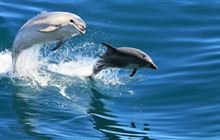Working with Bay of Island boat owners to protect local dolphins
Archived content: This media release was accurate on the date of publication.
Introduction
DOC has begun working with boat owners, iwi and the wider Bay of Islands community on ways to better manage boat interactions with local bottlenose dolphins.Date: 07 April 2016
A Massey University report, commissioned by DOC, indicates a very high level of interaction between boats and dolphins, and an ongoing fall in the local bottlenose dolphin population in the Bay of Islands.
The local bottlenose population has fallen from more than 250 individuals to fewer than 100 in the past 15 years.
Bottlenose dolphins are found around the world and the global population is not endangered. However bottlenose dolphins living in New Zealand are classified as endangered because the three main populations are small and more vulnerable.
There is a risk, if the local population continues to fall that bottlenose dolphins will be driven out of the Bay of Islands.
DOC Northern North Island Director of Operations, Sue Reed-Thomas says Bay of Islands bottlenose dolphins are facing a unique situation because of the very heavy boat traffic in the area.
"The Bay of Islands is a boating Mecca with a high density of boats on the water. As a result the study shows dolphins in the area are spending 86% of their daylight hours in the presence of at least one boat."
"This is very disruptive for the dolphins. It means they spend far less time feeding, nursing their young and sleeping."
"We know people love dolphins. People are simply loving them too much," says Sue Reed-Thomas.
The majority of interactions involves private boats and commercial vessels taking tourists around the Bay of Islands. These boat owners interact with dolphins when they see them while cruising.
"It's very difficult to manage a group of wild animals swimming freely. The dolphins often swim towards boats themselves and you simply can't put a barrier around them or monitor every interaction they have," says Sue Reed-Thomas.
"Everyone who puts a boat on the water in the Bay of Islands needs to be aware of the problem so they play their part in protecting the local dolphin population."
DOC has already picked up on some of the recommendations in the Massey scientists' report.
"We've begun talking to local boat operators and iwi as part of an education and engagement programme. We will also be maintaining our moratorium on new commercial dolphin watching operations in the region and looking at strengthening local marine mammal regulations," says Sue Reed-Thomas.
"DOC will continue working with all boat owners operating in the Bay of Islands - plus iwi and the wider community - to develop a co-ordinated and effective response to this issue," says Sue Reed-Thomas.
View the report
Responses of bottlenose dolphin to vessel activity in Northland.
Background information
Bottlenose dolphins are widely distributed around the world and at a global level the species is not considered endangered. However New Zealand's resident bottlenose dolphin populations are relatively small and centred around coastal areas in the Bay of Islands, Fiordland and the north western South Island regions.
There are believed to be less than 1000 bottlenose dolphins across these populations and in New Zealand they are classified as nationally endangered.
Commercial operators require permits to run dolphin watching tours which set out specific conditions to protect dolphins from undue stress.
Contact
For media enquiries contact:
Email: media@doc.govt.nz


